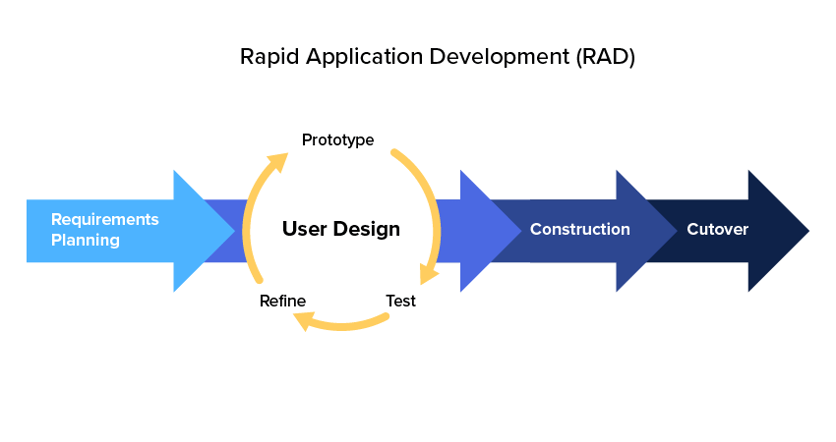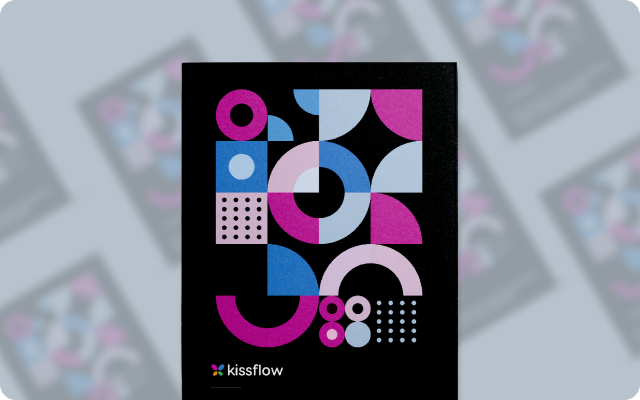What is the meaning of RAD?
Rapid Application Development (RAD) is built on development and testing and an agile approach with little (or no) preparation ahead of time. Taking a RAD approach to software development involves focusing less on preparation than on the development and advancement of a project.
RAD is a development paradigm that arose from realizing that the conventional waterfall model of development was ineffective. The waterfall prototype has a big drawback in that it’s impossible to modify the software’s key features and specifications until it’s in the testing process. As a result, you’re left with applications that can or cannot meet your changing needs.
The waterfall prototype has a big drawback in that it’s impossible to modify the software’s key features and specifications until it’s in the testing process. As a result, you’re left with applications that can or cannot meet your changing needs.

What are the phases in RAD (Rapid Application Development)
While RAD system has evolved, these four fundamental phases of rapid application development have remained consistent.
- Define the requirements: Rapid application development distinguishes itself from standard computing paradigms right away. It doesn’t ask for a comprehensive list of requirements from end-users; rather, it asks for a wide criterion. The general structure of the specifications makes it easier to include exact needs at various stages of the development process.
- Prototype: This is where much of the action takes place. Rather than adhering to a specific set of specifications, companies create designs of various functionality and configurations as quickly as possible. The clients are then shown the samples and asked to determine what they do and don’t like. Most of the time, these designs are rushed to function to demonstrate specific functionality without a sufficient finish. It is natural, and the finished result is only generated when both the customer and the programmer agree on the final product at the completion phase.
- Receive feedback: Feedback on what’s fine, what’s not, what functions, and what doesn’t is shared at this point. Not only is feedback restricted to pure features, but it also includes graphics and frameworks. Prototyping begins with this feedback in consideration. These two processes are repeated before a finished design is produced that meets the needs of both the programmers and the consumers.
- Finalize Software: The consumer finalizes the software’s specifications, operations, layout, and interface here. Until providing to the customer, reliability, accessibility, and maintainability are critical.
Pros and Cons of RAD
Through these moves, it may seem that app construction is a good idea for all programs, but that is a bit of a reach. RAD software is ideal for small groups and short-term ventures. However, it is not a panacea for all problems. Here are a few pros and cons of using rapid application development:
Pros and Cons of RAD
|
| Pros of RAD |
Cons of RAD |
| Specifications are subject to alteration at any point. |
Good teamwork is needed. |
| Prioritizes and promotes input from customers. |
Cannot function in big groups. |
| The responses are fast. |
Extremely competent programmers are needed. |
| The duration required for the production has been greatly decreased. |
Consumer requirements must be met during the project’s lifecycle. |
| Implementation is not a concern since it is built in from the start of the project. |
Rapid application development is only used to create applications that can be modularized. |
| The period among concepts and implementations is restricted. |
When contrasted to other versions, it is more difficult to handle. |
Why is the RAD system important?
The Rapid Application Development (RAD) system is important for the following reasons:
When You Can Evaluate Your Designs Efficiently: Rapid application development is a perfect model to adopt if you have several people who can provide authentic and precise input on the prototypes you create. Prototypes produced using the rapid application development model rely on input from previous implementations, so accurate feedback from legitimate sources can be extremely beneficial.
When You Have a Plan: Rapid application development (RAD) is comparatively cost-effective compared to other engineering styles, but it can be costly in some cases. Recruiting skilled employees necessitates paying them appropriately. The good news is that if you have the resources, you can move an idea from prototype to finished product even faster than most models.
Learn more: How much does it cost to develop an application?
When You Need a Task Finished Right Away: Rapid application development model is the best chance if you have a strict timeline. If you’re under obligation to offer anything which works, a RAD network can be the right approach. If you don’t have the resources to go through a lengthy configuration preparation and development phase, rapid application development code is your best option. Rapid application development employs an on-the-fly methodology, which sounds plausible with rapid development that can pivot on a quarter.
How Will Kissflow Accelerate RAD?
There is no question that using rapid application development methods is the most effective way to create applications. Although it is still the winner, the world has changed a lot in the last 20 years.
Kissflow is an example of rapid application development’s latest century. It is a no-code system that allows everyone to create their ideal automatic system in minutes rather than days or weeks. A specific individual may use Kissflow to focus on application development. It is rapid application development brought to a whole new level–creating solutions as early as possible for use by the whole enterprise right away.
Kissflow's rapid application development platform is developed around the idea that businesses want solutions to make their life simpler. It has visual interface templates to build templates efficiently and easily, pre-built frameworks, so you don’t have to do the real work, and drag-and-drop coding to offer a modification to those who don’t have the necessary coding skills.
FAQs
How does RAD work?
Rapid Application Development (RAD) is an agile methodology that emphasizes rapid prototype launches and prototypes. Unlike the Waterfall approach, RAD prioritizes applications and user input over rigid preparation and requirements information.
What is the rapid application development model?
The Rapid Application Development (or RAD) model is built on the development and testing and agile methodology with little (or no) preparation. In general, the RAD software development process involves focusing less on organizing projects but more on the development and advancement of a model.
When would you use RAD solution?
If a device can be possibly enhanced and implemented incrementally, RAD solution can be used. It can be used if there is wide flexibility of Modeling designers. It can only be used if the finances allow for the use of automatic code generation software.








![Rapid Application Development Model: The RAD Model in 2022 [New]](https://kissflow.com/hs-fs/hubfs/RAD-Model-Feature.png?width=352&name=RAD-Model-Feature.png)


